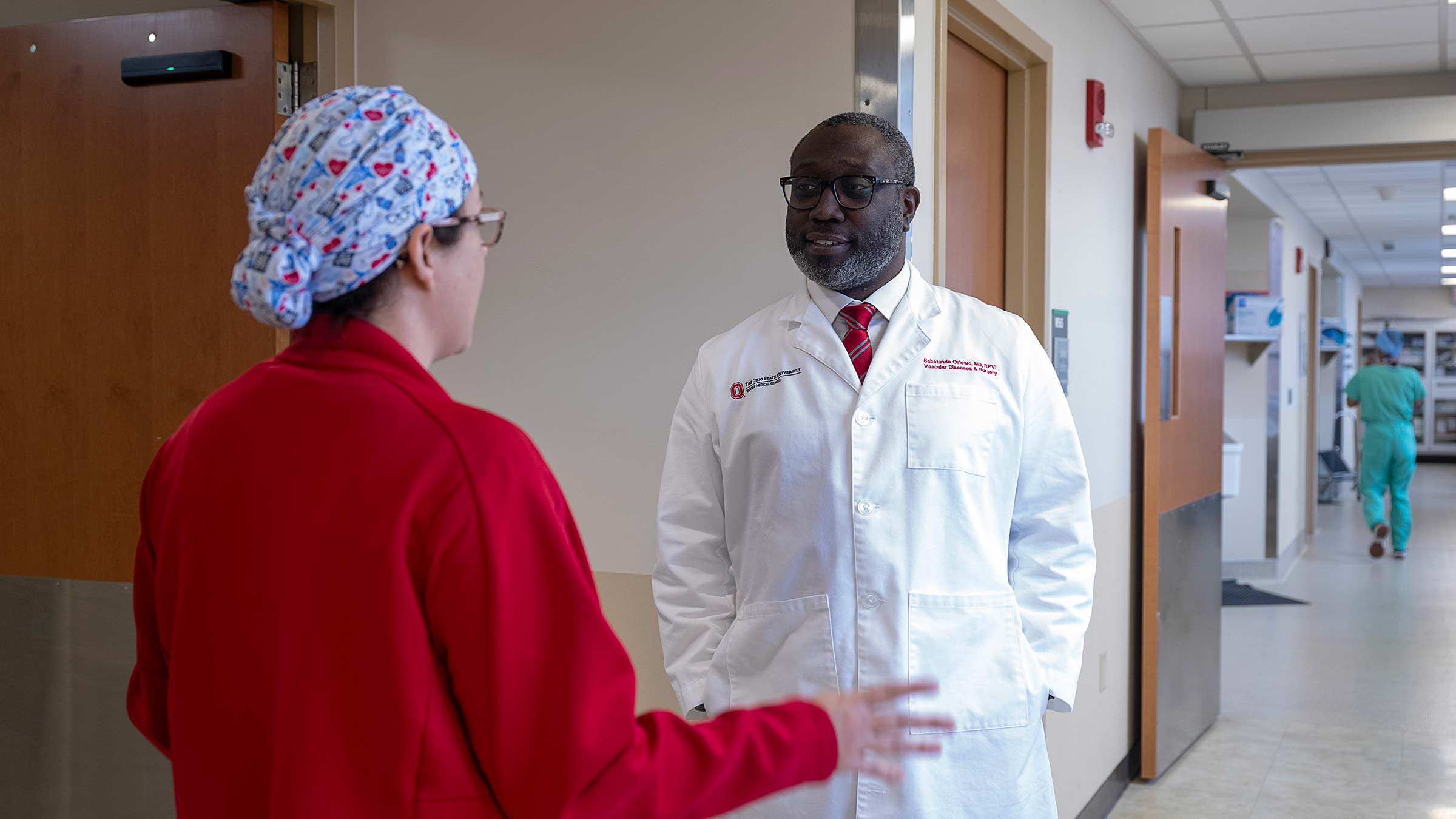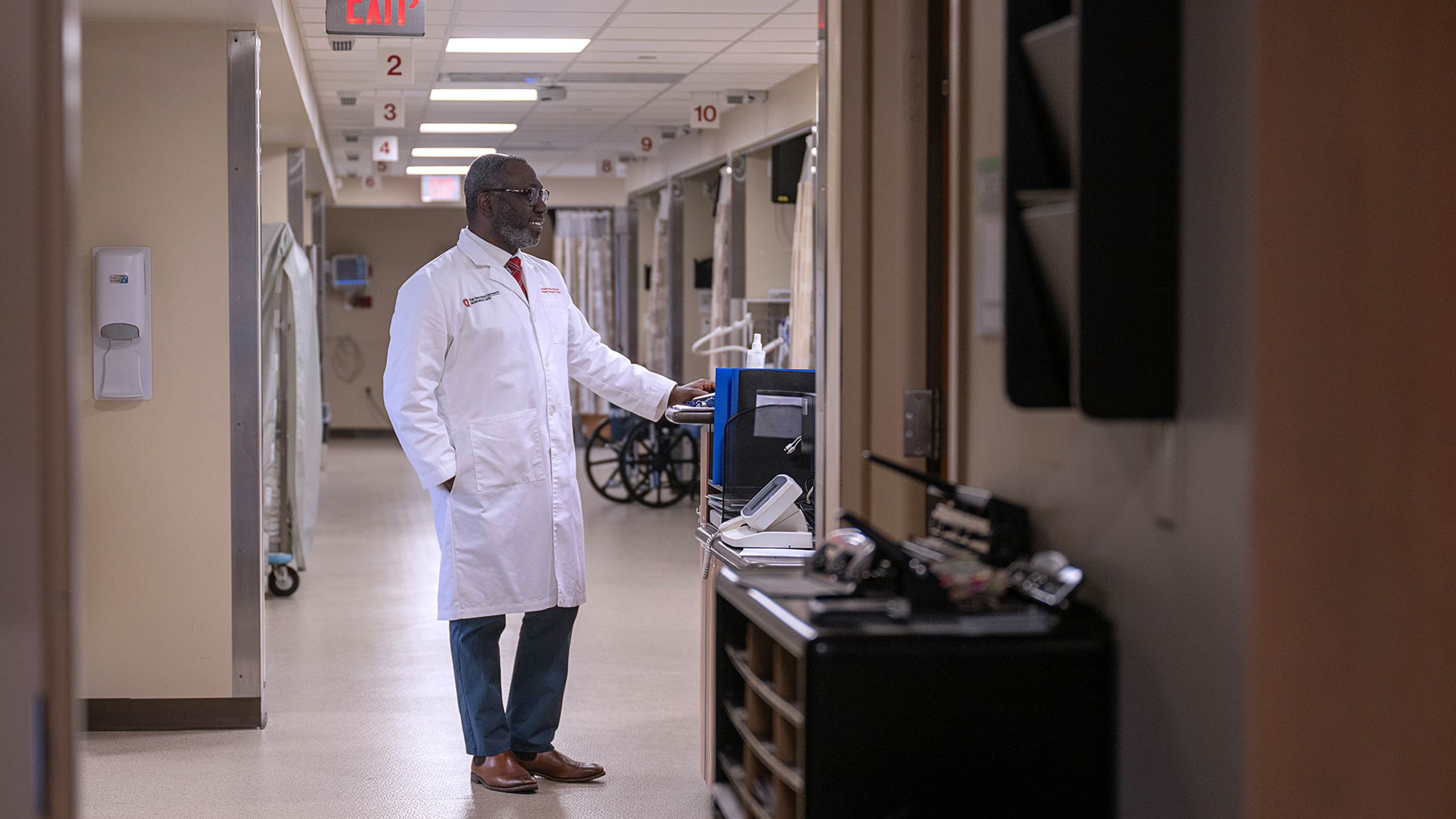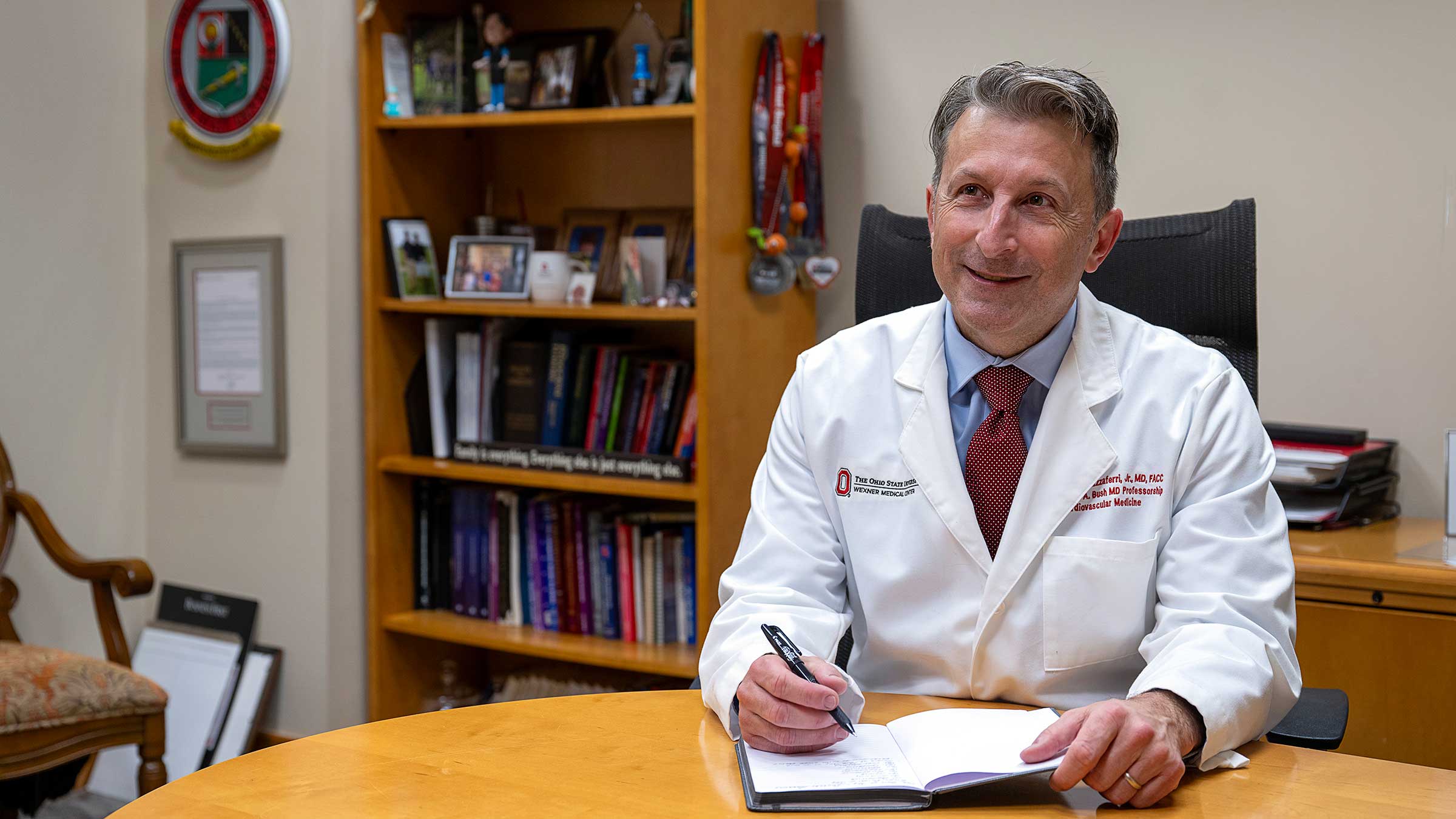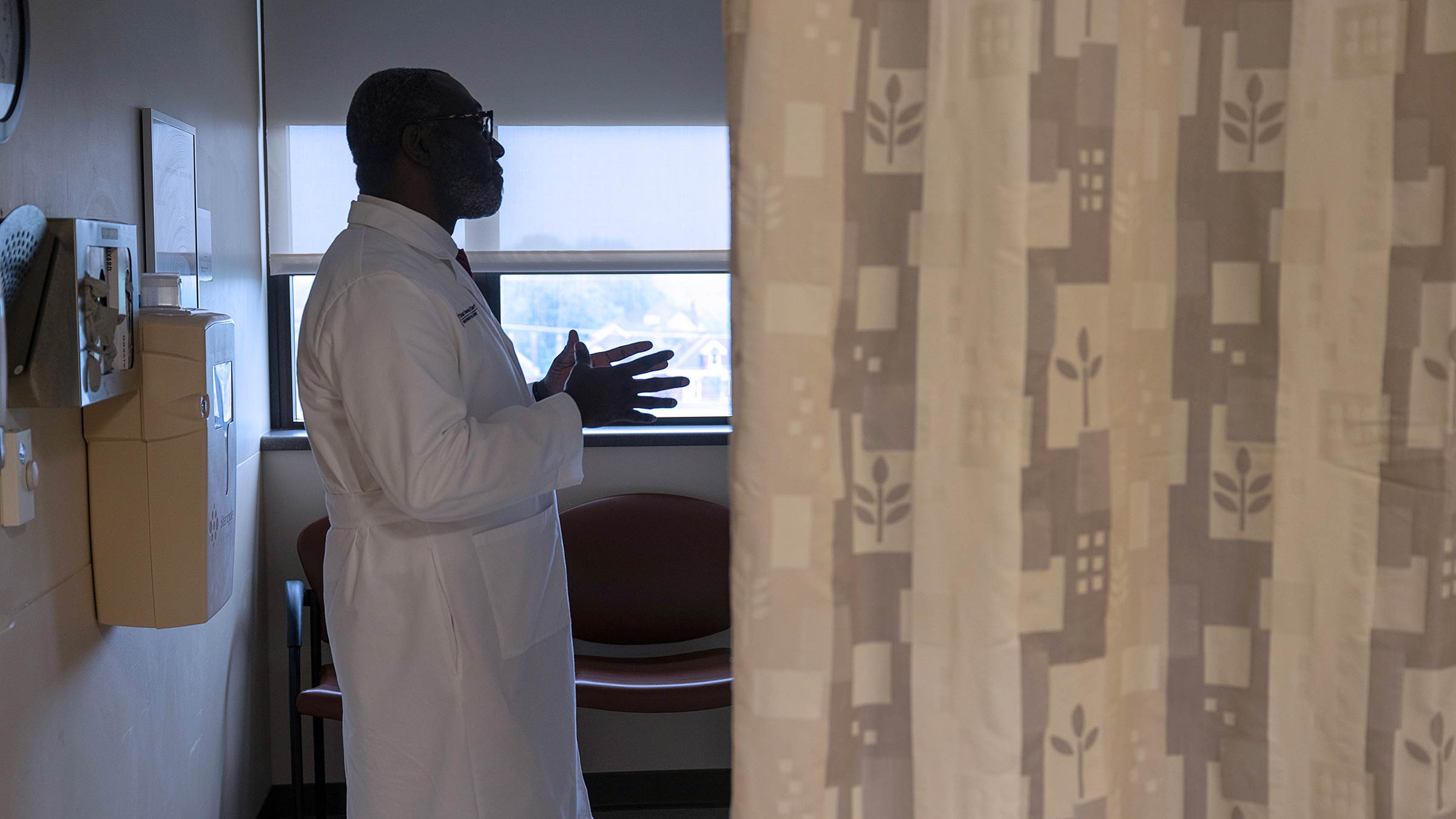Vascular surgeon aims to help community at risk for PAD
Babatunde Oriowo, MBBS, is expanding access to care for a common yet life-threatening vascular condition that disproportionately affects minorities.
You can see the concern on their faces.
Patients come to the 12th floor at The Ohio State University Wexner Medical Center East Hospital because circulation problems have taken something from them and may take more yet.
Some have swelling in their legs that has made it hard to walk. Others have lost toes, and they fear that amputation of a foot — or more — might be necessary. Still others have already had parts of their legs removed.
These patients have peripheral artery disease (PAD), which often occurs when fat and cholesterol collect as plaque in the blood vessels, narrowing those vessels and causing a reduction in blood flow to limbs. It most often affects the legs and feet.
Millions in the United States have this condition, and it disproportionately affects people along lower socioeconomic lines. The population that lives near Ohio State East Hospital, on the Near East Side of Columbus, is among the highest-risk groups for PAD.
Vascular surgeon Babatunde Oriowo, MBBS, is helping to bring hope and comfort to those patients by starting a program focused on treating PAD and helping patients reduce their risk of it worsening.

PAD, a devastating condition
More than 200 million people worldwide have peripheral artery disease, with 12 million of them in the United States, according to the American Heart Association (AHA). And these are just the ones we know about — in many cases, the disease goes undetected for years until symptoms appear.
As the arterial plaque buildup continues — a condition known as atherosclerosis — symptoms of PAD arise. They can be mild at first: pain in the feet, sores that heal slowly. But as the disease progresses, significant risks come along with it.
If an artery becomes blocked, the tissue downstream of it will die, and amputation of a foot or leg can become necessary. People with atherosclerosis in their legs also tend to have it in other parts of the body, increasing their risk of stroke or heart attack.
Early detection is critical in all diseases, but especially so in PAD. The sooner that blood flow to the limb can be improved, or the progression of the plaque buildup slowed, at least, the more likely it is that the disease will not progress to life-altering status.
That’s where Dr. Oriowo comes in.

“The right person at the right time”
Dr. Oriowo’s passion for helping people with vascular diseases is what brought him back to the Ohio State Wexner Medical Center. It’s also where that passion first developed.
His parents emigrated from Nigeria to Vermont, and science and medicine were present in his upbringing — his mother is a nurse and his father is in pharmacology. He’d go on to spend stints growing up in England and Kuwait, where he completed medical school in 2007.
While he was in medical school, he learned that he preferred a hands-on approach and that he has a self-described “personality fit for surgery.” That personality is evident from his interactions with the patients he sees in clinic — he maintains an affable relationship with each of them, while being direct about the circumstances they’re facing and the changes they can make to improve their outcomes.
In 2014, he began a vascular surgery fellowship at the Ohio State Wexner Medical Center. It would change his life in more ways than one — he met his wife during the two-year program, and they now have two sons, ages 3 and 1.
The memory of being selected for the fellowship stands out.
“I matched here as my first choice, and I was just over the moon that that was even possible,” Dr. Oriowo recalls. “I got a real appreciation for my faculty and mentors at that time, and really just the love for Columbus as somewhere to live.”
After completing the fellowship, he spent eight years helping run a vascular surgery fellowship program in Toledo, Ohio. That experience impressed Ernest Mazzaferri, MD, FACC, interim co-director of The Ohio State University Heart and Vascular Center and medical director of Heart and Vascular Center Clinical Operations.
“He comes with the credibility that he can build a program,” Dr. Mazzaferri says. “We feel good about that, and he’s the right person at the right time.”

A vital resource for the community
The prevalence of PAD increases with age, and it disproportionately affects minorities. An AHA study showed that Black men over 50 had the highest rates of PAD among all populations, and that a Black man over 80 was nearly three times as likely to have PAD as a white person the same age.
Risk factors for the disease include smoking, diabetes and high blood pressure, but the study concluded that the prevalence of PAD remained higher for Black patients even when accounting for these.
East Hospital is an ideal location to have services directed at treating this disease, Dr. Mazzaferri says. It’s in the King-Lincoln Bronzeville neighborhood of Columbus, which has about four Black residents for every three white ones, according to 2020 U.S. Census data.
“Peripheral vascular diseases are very underdiagnosed, so there’s a lot of people out there who aren’t being treated for their disease. We are thrilled to have a program to better serve the community,” Dr. Mazzaferri says.
Prior to Dr. Oriowo’s arrival in late 2024, patients from the Near East Side needed to travel to the main medical center campus for PAD treatments. Many refused for a variety of reasons, lack of access to transportation being a major one. His arrival, and the expansion of the vascular surgery program there, is a key step in bringing care closer to home.
Having care nearby benefits patients in myriad ways — it helps establish trust with physicians, and having relationships with those doctors leads to more consistent adherence to treatment plans and better advocacy for themselves.
“If there are services that we can provide at a community hospital like East Hospital, then it’s much better for patients and families to provide them locally,” Dr. Mazzaferri says.

Opportunity for growth
Dr. Oriowo sees enormous potential to expand the vascular surgery program at East Hospital.
Already, he’s performing some bedrock procedures to treat PAD — like inserting stents in blood vessels to improve blood flow. He sees about 25 to 30 patients at his weekly clinic sessions, where he works with a team of about six people — a vascular surgery resident assists him in seeing patients, and several nurses are among the others involved. He plans to expand the PAD program to include larger surgeries in the coming years.
The impact of that work can go beyond improved health outcomes, says Michael Go, MD, a vascular surgeon at the Ohio State Wexner Medical Center who spent about a decade caring for patients at East Hospital.
He sees a great opportunity for Dr. Oriowo to become a part of the neighborhood.
“Once you earn these patients’ trust, you’ve earned it for life,” Dr. Go says. “You take care of family members, friends. You’re in the community. He’ll end up going to funerals, birthday parties, community events.
“It’s a pretty special area that will really cleave to someone who is there for them.”
So far, it’s been a great fit for Dr. Oriowo.
“All I can be is my authentic self, take it or leave it, and hopefully that’s something that more people want to take than leave,” he says. “I’ve found the group to be just very welcoming.
“Things are growing, things are changing, they’d love to have me help out. That’s how I felt through this entire process.”

Your heart is in the right place
Learn more about advances in care and treatment for patients at The Ohio State University Heart and Vascular Center
Expert care starts here



